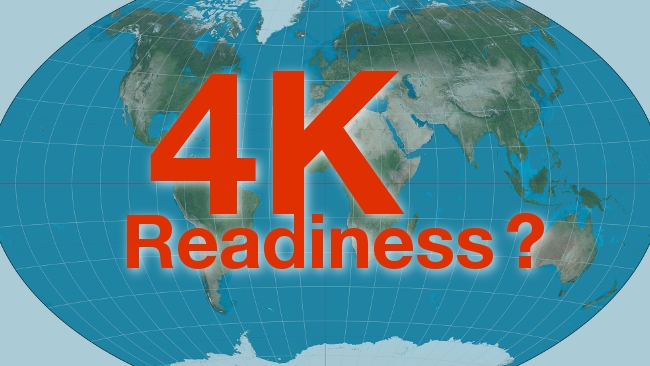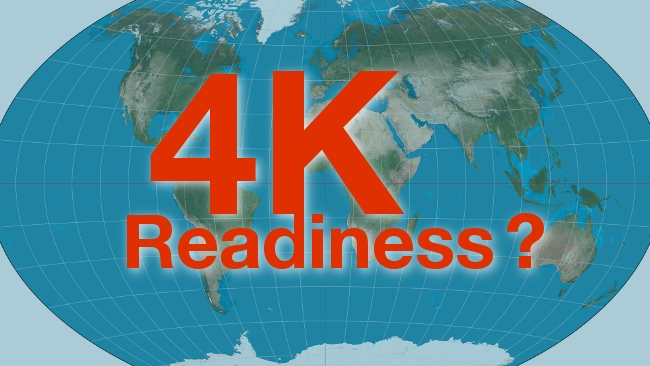
 4K Readiness Featured Image
4K Readiness Featured Image
According to a recent study on worldwide internet speeds, there was almost a 100% increase, year over year, in reaching the broadband threshold necessary to receive 4K transmissions. But the report also revealed a few other surprises.
2014 has been a banner year for 4K as it pertains to film professionals and content creators, as there have been a slew of new cameras, displays, and other devices that support 4K workflow. Of course, many of these 4K images captured will eventually down scaled, achieving greater detail or more flexibility to crop the image in post for HD delivery.
While our industry seems all-in on 4K (and higher) resolution capture, HD delivery is still king for broadcast and streaming, as both UHD display market penetration and broadband speeds lag behind 4K acquisition options. One could argue that there's also a dearth of 4K content, but such criticism is misleading; if there were ample displays in use, and if broadband speeds were boosted to match, then you could expect that scores of 4K/UHD content would arrive shortly after.
A report just published by Akamai Technologies on the 2014 State of the Internet tells of a 98% increase in global 4K readiness, which is defined as achieving the broadband speed of above 15Mbps. It is generally held that compressed UltraHD streams will require between 10-20Mbps, so that 15Mbps figure makes sense as a baseline for "4K readiness," although in reality, most households will need much more, depending on the number of streaming devices in use while receiving 4K transmissions. Still, if we take the 15 Mbps figure as a common sense initial benchmark, then we can begin to diagnose the 4K readiness of various countries.
South Korea leads, China lags
It probably doesn't come as a big surprise that South Korea, a small and very industrialized (or modern, if you prefer) nation would boast a high level of 4K readiness. According to the survey, South Korea is tops worldwide at 62% of its connection surpassing that 15 Mbps figure. But it might be somewhat of a shock that China, who far and away leads the world in UHD display shipments and market penetration, achieved under 1% 4K readiness. When you look at another sub-one percent country, India, you can begin to see why China scores so low. Extremely populous countries, with a deep division between urban and rural lifestyles, score low in such tests, as entire regions of those countries have substandard internet speeds, if any at all.
Scandinavia best in Europe, Romania on the move
The triumvirate of Switzerland, Sweden, and the Netherlands top the chart throughout the European continent, with Switzerland king of the mount with a robust 33% 4K readiness, good for 4th globally, just behind Japan.
For those that don't regularly travel to Romania, you may not consider the country at the forefront of the technological winds, but in terms of 4K readiness (and internet speeds in general), you would be wrong. In 2013, Romania ranked number 5 worldwide in terms of average connection speeds at 37.4 Mbps, according to Bloomberg, and some report the country reaching 47.9 Mbps average this year. It seems that there is a strong movement, nationwide, to increase speeds in all areas, as the Akamai report states that over one quarter, the 4K readiness of the country actually doubled, from 11% to 22%, good enough for number 10 globally.
Where do the U.S. & U.K. rank in 4K readiness?
The United States rates an average of 11.4 Mbps, putting it in 14th place in internet connection speed. What's interesting is that United States actually leads the world in unique IPv4 addresses and ranks 6th in newer IP6v addresses. The country's sky high internet penetration is undercut by the dogged unwillingness of U.S. internet service providers (ISPs) to increase connection speeds, although that is slowly changing in competitive urban markets. Still, these ISPs are fighting progress tooth and nail, as they are in solidarity in lobbying for the threshold for 'broadband' service designation to remain at 4Mbps instead of the FCC proposed 10 Mbps.
All this translates into the United States ranking number 15 globally in 4K readiness, with 19% of connections above 15 Mbps, below the aforementioned leaders, as well as Hong Kong, Latvia, Norway, the Czech Republic and the U.K, which placed 11th in this survey.
Here's a link to the Akamai site, where 2014 State of the Internet report can be downloaded.
Here's another link to the report on Slideshare.
Tags: Business


Comments